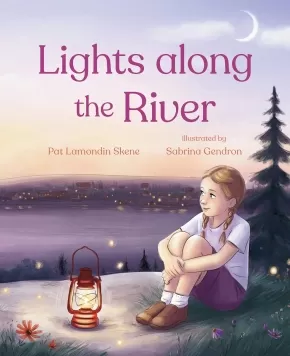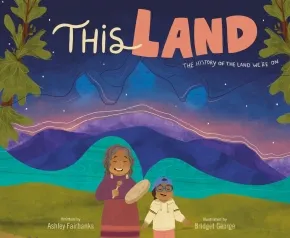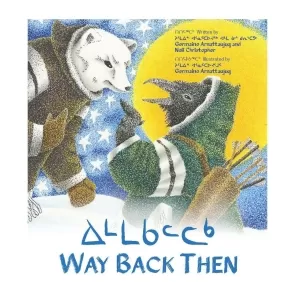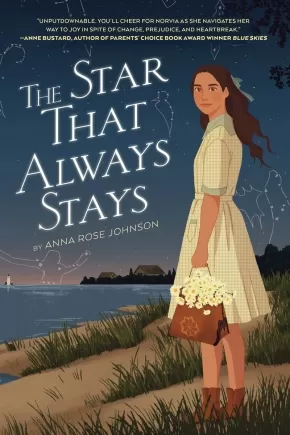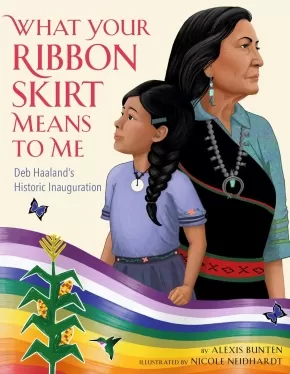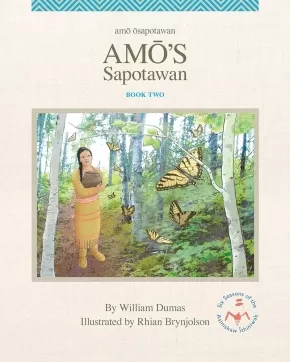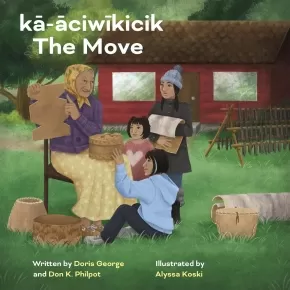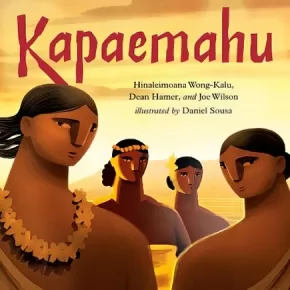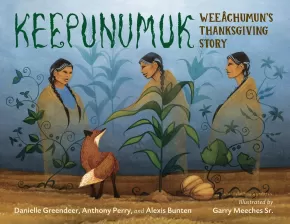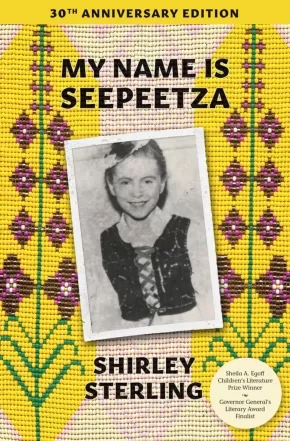
Historical Fiction
16
-
30
of
106 Results;
Sort By
Go To
of 8
Lights along the River
$21.95
Artists:
Format:
Hardcover
Text Content Territories:
Indigenous Canadian; Métis;
ISBN / Barcode: 9781459836518
Synopsis:
Synopsis:
On a cold winter morning in 1952, Patsy Lamondin wakes to the day electricity will finally be connected to her small town along the Magnetawan River.
Patsy and her siblings buzz with excitement, eagerly awaiting the ceremony being held at the center of town. The Lamondins have lived along the waters of Georgian Bay and the Magnetawan River for generations. They are a Métis family who love music, dancing and being outdoors, and Patsy ponders how electricity will change all of their daily lives. What she knows for sure is that, whatever changes, she will always feel she belongs here.
Educator Information
Recommended for ages 6 to 8.
Fountas & Pinnell Text Level Gradient: M
Lexile measure: 660L
Guided Reading Level: M
Recommended in the Indigenous Books for Schools catalogue as a valuable resource for English Language Arts and Science in grades 1 to 3.
Themes: Childhood, Community, Family, History, Technology, Engineering.
Additional Information
32 pages | 8.75" x 10.75" | Hardcover
This Land: The History of the Land We're On
$24.99
Format:
Hardcover
Text Content Territories:
Indigenous American; Native American; Anishinaabeg;
ISBN / Barcode: 9780593651445
Synopsis:Lexile measure: AD630L
Synopsis:
This land is your land now, but who did it belong to before? This engaging primer about native lands invites kids to trace history and explore their communities.
Before my family lived in this house, a different family did, and before them, another family, and another before them. And before that, the family who that lived here lived not in a house, but a wigwam. Who lived where you are before you got there?
This Land teaches readers that American land, from our backyards to our schools to Disney World, are the traditional homelands of many Indigenous nations. This Land will spark curiosity and encourage readers to explore the history of the places they live and the people who have lived there throughout time and today.
Reviews
"This work aptly communicates the issue of land acknowledgments . . . A memorable message." —Publishers Weekly, starred review
"A stirring tale that fosters respect for Native peoples." —Kirkus Reviews
Educator Information
Recommended for ages 4 to 8.
Fountas & Pinnell Text Level Gradient: M
Additional Information
40 pages | 11.37" x 9.37" | Hardcover
Way Back Then (PB)
$16.95
Artists:
Format:
Paperback
Text Content Territories:
Indigenous Canadian; Inuit;
ISBN / Barcode: 9781772270211
Synopsis:
Synopsis:
Kudlu's children will not go to sleep until he tells them a story of long ago. Before they will shut their eyes, they want to hear about a time long before Kudlu was born, a time when the world was magic. Before they can sleep, they want to hear about giants, animals disguised as humans, little people the size of lemmings, and all of the other wonderful things that existed way back then.
Educator Information
Recommended for ages 6 to 8.
Bilingual: English and Inuktitut
Reviews
“A bilingual sampler—cold of setting but warm of spirit.” — ★ Kirkus
Additional Information
44 pages | 8.75" x 8.75" | Paperback
A Girl Called Echo Omnibus
$38.00
Artists:
Format:
Paperback
Text Content Territories:
Indigenous Canadian; Métis;
ISBN / Barcode: 9781774920886
Synopsis:
Synopsis:
Métis teenager Echo Desjardins is struggling to adjust to a new school and a new home. When an ordinary history class turns extraordinary, Echo is pulled into a time-travelling adventure. Follow Echo as she experiences pivotal events from Métis history and imagines what the future might hold. This omnibus edition includes all four volumes in the A Girl Called Echo series:
In Pemmican Wars, Echo finds herself transported to the prairies of 1814. She witnesses a bison hunt, visits a Métis camp, and travels the fur-trade routes. Experience the perilous era of the Pemmican Wars and the events that lead to the Battle of Seven Oaks.
In Red River Resistance, we join Echo on the banks of the Red River in the summer of 1869. Canadian surveyors have arrived and Métis families, who have lived there for generations, are losing their land. As the Resistance takes hold, Echo fears for the future of her people in Red River.
In Northwest Resistance, Echo travels to 1885. The bison are gone and settlers from the East are arriving in droves. The Métis face starvation and uncertainty as both their survival and traditional way of life are threatened. The Canadian government has ignored their petitions, but hope rises with the return of Louis Riel.
In Road Allowance Era, Echo returns to 1885. Louis Riel is standing trial, and the government has not fulfilled its promise of land for the Métis. Burnt out of their home in Ste. Madeleine, Echo’s people make their way to Rooster Town, a shanty community on the southwest edges of Winnipeg. In this final instalment, Echo is reminded of the strength and perseverance of the Métis.
This special omnibus edition of Katherena Vermette’s best-selling series features an all-new foreword by Chantal Fiola (Returning to Ceremony: Spirituality in Manitoba Métis Communities), a historical timeline, and an essay about Métis being and belonging by Brenda Macdougall (Contours of a People: Métis Family, Mobility, and History).
Educator & Series Information
Recommended for ages 12 to 18.
This omnibus edition includes all four volumes in the A Girl Called Echo series:
- Pemmican Wars
- Red River Resistance
- Northwest Resistance
- Road Allowance Era
This special omnibus edition also includes an all-new foreword by Chantal Fiola, a historical timeline, and an essay about Métis being and belonging by Brenda Macdougall
Additional Information
224 pages | 6.50" x 10.00" | Full colour throughout | Paperback
Bernice and the Georgian Bay Gold
$12.95
Artists:
Format:
Paperback
Text Content Territories:
Indigenous Canadian; Métis;
ISBN / Barcode: 9781772603187
Synopsis:
Synopsis:
It's the summer of 1914. Eight-year-old Bernice lives with her family in a lighthouse on Georgian Bay. One day Bernice wakes up to find a stranger named Tom Thomson sleeping in their living room. When she overhears him talk about gold on a nearby island, Bernice is determined to find it. Inspired by her beloved Mémèr’s stories of their Métis family’s adventures and hardships, Bernice takes the treasure map the stranger left behind and sets out in a rowboat with nothing more than her two dogs for company and the dream of changing her family’s fortunes forever.
Educator Information
Ages 9 to 12.
Additional Information
190 pages | 7.50" x 5.25" | Paperback
My Powerful Hair
$23.99
Artists:
Format:
Hardcover
Text Content Territories:
Indigenous American; Native American; Anishinaabeg; Ojibwe (Chippewa); Turtle Mountain Anishinaabe; Métis;
ISBN / Barcode: 9781419759437
Synopsis:
Synopsis:
From the award-winning and bestselling author of We Are Water Protectors comes an empowering picture book about family history, self-expression, and reclaiming your identity
Our ancestors say our hair is our memories,
our source of strength and power,
a celebration of our lives.
Mom never had long hair—she was told it was too wild. Grandma couldn’t have long hair—hers was taken from her. But one young girl can’t wait to grow her hair long: for herself, for her family, for her connection to her culture and the Earth, and to honor the strength and resilience of those who came before her.
From Carole Lindstrom, author of the New York Times bestseller and Caldecott Medal winner We Are Water Protectors, and debut illustrator Steph Littlebird comes an empowering and healing celebration of hair and its significance across Indigenous cultures.
Educator Information
Recommended for ages 4 to 8.
Additional Information
48 pages | 9.00" x 11.00" | Hardcover
Suliewey: The Sequel to My Indian
$16.95
Format:
Paperback
Text Content Territories:
Indigenous Canadian; First Nations; Beothuk; Mi'kmaq;
ISBN / Barcode: 9781550819885
Synopsis:
Synopsis:
Suliewey: The Sequel to My Indian continues the story of Mi’kmaw guide Sylvester Joe, whose traditional name is Suliewey, as he seeks out the last remaining Beothuk community.
In My Indian, Sylvester was hired by William Cormack in 1822 to guide him across Newfoundland in search of Beothuk encampments. In fact, he followed the advice of his Elders and guided Cormack away from the Beothuk.
In this sequel, having parted ways with Cormack at St. George’s Bay, Sylvester decides to go out on his own, in search of the winter camp of the last of the remaining Beothuk.
Written as fiction, by two Mi’kmaq authors, Suliewey: The Sequel to My Indian supports Mi’kmaq oral history of friendly relationships with the Beothuk.
The novel reclaims the settler narrative that the Beothuk and the Mi’kmaq of Newfoundland were enemies and represents an existing kinship between the Mi’kmaq and the Beothuk.
Rich in oral history, the descriptions of traditional ceremonies and sacred medicines, the use of Mi’kmaw language, and the teachings of two-spirit place readers on the land and embed them in the strong relationships described throughout the book.
Educator & Series Information
Recommended for ages 12 to 14.
This is the second book in the My Indian series.
Additional Information
232 pages | 5.25" x 8.00" | b&w illustrations | Paperback
232 pages | 5.25" x 8.00" | b&w illustrations | Paperback
The Star That Always Stays (PB)
$14.99
Format:
Paperback
Text Content Territories:
Indigenous American; Native American; Anishinaabeg; Ojibwe (Chippewa);
ISBN / Barcode: 9780823456109
Synopsis:
Synopsis:
When bright and spirited Norvia moves from the country to the city, she has to live by one new rule: Never let anyone know you’re Ojibwe.
Growing up on Beaver Island, Grand-père told Norvia stories—stories about her ancestor Migizi, about Biboonke-o-nini the Wintermaker, about the Crane Clan and the Reindeer Clan. He sang her songs in the old language, and her grandmothers taught her to make story quilts and maple candy. On the island, Norvia was proud of her Ojibwe heritage.
Things are different in the city. Here, Norvia’s mother forces her to pretend she’s not Native at all—even to Mr. Ward, Ma’s new husband, and to Vernon, Norvia’s irritating new stepbrother. In fact, there are a lot of changes in the city: ten-cent movies, gleaming soda shops, speedy automobiles, ninth grade. It’s dizzying for a girl who grew up on the forested shores of Lake Michigan.
Despite the move, the upheaval, and the looming threat of world war, Norvia and her siblings—all five of them—are determined to make 1914 their best year ever. Norvia is certain that her future—both professionally and socially—depends upon it... and upon her discretion.
But how can she have the best year ever if she has to hide who she truly is?
Sensitive, enthralling, and classic in sensibility (perfect for Anne of Green Gables fans), this tender coming-of-age story about an introspective and brilliant Native American heroine thoughtfully addresses serious issues like assimilation, racism, and divorce, as well as everygirl problems like first crushes, making friends, fitting in, and the joys and pains of a blended family. Often funny, often heartbreaking, The Star That Always Stays is a fresh and vivid story directly inspired by Anna Rose Johnson’s family history.
Reviews
"Inspired by the author’s family history, this gentle novel nimbly and tenderly confronts topics including prejudice, the challenge of blending families, young love, and staying true to oneself."—Kirkus Reviews
Educator Information
Recommended for ages 8 to 12.
Additional Information
288 pages | 5.49" x 8.25" | Paperback
What Your Ribbon Skirt Means to Me: Deb Haaland's Historic Inauguration
$24.99
Artists:
Format:
Hardcover
Text Content Territories:
Indigenous American; Native American; Laguna Pueblo;
ISBN / Barcode: 9780316430036
Synopsis:
Synopsis:
A contemporary Indigenous picture book that offers both an homage to Secretary Deb Haaland's achievements, and a celebration of urban Indigenous community through the eyes of a little girl.
Pia rushes over to the Indigenous community center after school. It’s where she goes every day to play outside with friends and work on her homework. But today—March 18, 2021—is special: Auntie Autumn gathers all the children around their television to witness Secretary Deb Haaland in her ribbon skirt at the White House as she becomes the first Native American to serve as a cabinet secretary. Pia and the other kids behold her Native pride on an international stage.
Together with their parents and Elders, the children explore the values woven into their own regalia, land, community, and traditions, making precious memories on this day they won’t soon forget.
Reviews
"Bunten (Aleut/Yup’ik) engages readers with lively language. Neidhardt’s (Diné) bold, realistic art radiates with strength, especially when Pia’s grandmother teaches her about the importance of regalia. A powerful story of intergenerational strength, womanhood, and Native pride."—Kirkus Reviews, starred review
"This simple story . . . artfully folds in all kinds of cultural details about Indigenous ceremonies, customs, and beliefs. Filled with bright, full-page illustrations, this attractive publication celebrates multiple urban and intertribal Native American traditions."—Booklist, starred review
Educator Information
Recommended for ages 4 to 8.
Additional Information
40 pages | 8.90" x 11.25" | Hardcover
Amo's Sapotawan
$33.00
Artists:
Format:
Hardcover
Text Content Territories:
Indigenous Canadian; First Nations; Cree (Nehiyawak); Woodland Cree; Rocky Cree;
ISBN / Barcode: 9781553799290
Synopsis:
Synopsis:
A Rocky Cree girl must choose the skill that will define her miskanaw, the path of her life, in the second book of The Six Seasons of the Asiniskaw Īthiniwak series.
Rocky Cree people understand that all children are born with four gifts or talents. When a child is old enough, they decide which gift, or mīthikowisiwin, they will seek to master. With her sapotawan ceremony fast approaching, Amō must choose her mīthikowisiwin. Her sister, Pīsim, became a midwife; others gather medicines or harvest fish. But none of those feel quite right.
Amō has always loved making things. Her uncle can show her how to make nipisiwata, willow baskets. Her grandmother can teach her how to make kwakwāywata, birchbark containers and plates. Her auntie has offered to begin Amō’s apprenticeship in making askihkwak, pottery.
What will Amō’s mīthikowisiwin be? Which skill should she choose? And how will she know what is right for her?
Educator & Series Information
Recommended for ages 9 to 11.
This is the second book in The Six Seasons of the Asiniskaw Īthiniwak series.
Reading Level: Fountas & Pinnell X
Includes some Cree language.
Additional Information
60 pages | 10.00" x 12.00" | Hardcover
How the Oceans Came to Be
$18.95
Format:
Paperback
Text Content Territories:
Indigenous American; Native American; Lumbee;
ISBN / Barcode: 9781939053442
Synopsis:
Synopsis:
In this delightful Lumbee story, clever Rabbit outsmarts a selfish Great Snapping Turtle. When Rabbit discovers many animals could not find water, he sets out to solve the mystery. What he finds is the Great Snapping Turtle blocking the water of the Mother Spring. When the stubborn turtle refuses to move, Rabbit figures out a way to let the water flow. As the water flowed to all creatures, it also created the oceans of Turtle Island.
Educator Information
Recommended for grades 2 and under.
Additional Information
40 pages | 8.00" x 10.00" | Paperback
kā-āciwīkicik / The Move (PB)
$14.95
Format:
Paperback
Text Content Territories:
Indigenous Canadian; First Nations; Cree (Nehiyawak); Swampy Cree ; Chemawawin First Nation ;
ISBN / Barcode: 9781772034288
Synopsis:
Synopsis:
A magical children’s picture book, written in Cree and English, depicting the transformation of a barren landscape into a rich natural world where an elderly couple can spend their remaining days.
Rooted in the historical displacement and relocation of members of the Chemawawin First Nation from their ancestral homeland, The Move is a bilingual story of two Cree Elders adjusting to life in their new environment. The story presents two contrasting landscapes of the old community—the homeland of the Chemawawin People—and the new community of Easterville, which at first appears barren and lifeless. Gradually, the couple begins to incorporate their old customs and traditions into their current surroundings. Family members begin to visit, and eventually nature begins to bloom all around them. Through traditional Cree storytelling techniques and vivid imagery, the new landscape springs to life and becomes a true community, filled with life and happiness.
Reviews
“kā-āciwīkicik / The Move is a small treasure. A wonderful story about memory, land, and kinship, and how language is integral to our relations with each other and with the land and all living things. This is a moving story of hope, wonderfully illustrated in tones that feel like earth, and with translation into Cree it invites us in, like a crackling fireplace in a log cabin, to sit with a cup of tea in hand and learn the old stories.” —Paul Seesequasis, bestselling author of Blanket Toss Under Midnight Sun
“My experience reading kā-āciwīkicik / The Move was profound. From the dreariness of relocation and searching for hope to finding happiness in reconnecting to culture—this story is both educational and poetic. Doris, Don and Alyssa balance healing in two worlds and do it beautifully through words, storyline, and graphics.” —Shayla Raine, author of The Way Creator Sees You
Educator Information
Recommended for ages 4 to 8.
Dual-Language: Cree and English.
Additional Information
48 pages | Paperback
Kapaemahu
$23.99
Artists:
Format:
Hardcover
Text Content Territories:
Indigenous Hawaiian; Indigenous Tahitian;
ISBN / Barcode: 9780593530061
Synopsis:
Synopsis:
An Indigenous story about how four extraordinary individuals of dual male and female spirit, or Mahu, brought healing arts from Tahiti to Hawaii, based on the Academy Award–contending short film.
In the 15th century, four Mahu sail from Tahiti to Hawaii and share their gifts of science and healing with the people of Waikiki. The islanders return this gift with a monument of four boulders in their honor, which the Mahu imbue with healing powers before disappearing.
As time passes, foreigners inhabit the island and the once-sacred stones are forgotten until the 1960s. Though the true story of these stones was not fully recovered, the power of the Mahu still calls out to those who pass by them at Waikiki Beach today.
With illuminating words and stunning illustrations by Hinaleimoana Wong-Kalu, Dean Hamer, Joe Wilson, and Daniel Sousa, Kapaemahu is a monument to an Indigenous Hawaiian legend and a classic in the making.
Additional Information
40 pages | 9.50" x 9.31" | Hardcover
Keepunumuk: Weeachumun's Thanksgiving Story
$22.99
Artists:
Format:
Hardcover
Text Content Territories:
Indigenous American; Native American; Wampanoag (Wôpanâak); Mashpee Wampanoag Tribe;
ISBN / Barcode: 9781623542900
Synopsis:
Synopsis:
In this Wampanoag story told in a Native tradition, two kids from the Mashpee Wampanoag tribe learn the story of Weeâchumun (corn) and the first Thanksgiving.
The Thanksgiving story that most Americans know celebrates the Pilgrims. But without members of the Wampanoag tribe who already lived on the land where the Pilgrims settled, the Pilgrims would never have made it through their first winter. And without Weeâchumun (corn), the Native people wouldn't have helped.
An important picture book honoring both the history and tradition that surrounds the story of the first Thanksgiving.
Reviews
"A Wamponoag grandmother plants her garden with weeâchumun (corn), beans, and squash, or the Three Sisters. When her grandchildren ask to hear the story of Thanksgiving, N8hkumuhs tells them that their people call it Keepunumuk, “the time of harvest,” and explains what really happened. The tale opens with Seagull warning Weeâchumun—depicted as a woman with a translucent body—of the Pilgrims’ arrival; Weeâchumun worries because many of the First Peoples who cared for her have gone to the Spirit World, and she fears this will be her last winter. Fox keeps an eye out and in spring tells Weeâchumun and her sisters that the newcomers endured a hard winter; many died. Weeâchumun and her sisters want to help: “We will send the First Peoples to help the newcomers.” The Wampanoag people teach the survivors how to plant corn, beans, and squash. The settlers hold a feast to celebrate the harvest; though it’s remembered by many as the first Thanksgiving, backmatter explains that because of the disease and warfare brought by the settlers, for the Wampanoag people, it is remembered as a day of mourning. Rich, saturated acrylics imbued with a touch of magic add to the vibrancy of this important, beautiful story. A much-needed Thanksgiving retelling that centers the Wamponoag people. (glossary, information on the Wampanoag map, recipes) (Picture book. 3-7)" —Kirkus, starred review
"This picture book features a contemporary Wampanoag grandmother and her grandchildren. N8hkumuhs shares the story of the Three Sisters—Corn, Beans, and Squash—and the first Thanksgiving, known as “Keepunumuk” by the Wampanoag people. The book transitions into a combination of history and storytelling about contact between the “First Peoples” and the newcomers. This format will be novel to some young children given the setting and timeframe of the story, though the book attempts to differentiate the parts that are the story by changing the typeface and including ethereal-like images of the Three Sisters. “Before You Begin” and “Important Words to Know” sections also provide context. Rich back matter includes more information about the Wampanoag tribes, a traditional recipe, and a photo and information about the real Maple and Quill, the grandchildren in the story. Overall, this story is a good addition for the historical knowledge of the first Thanksgiving from the Wampanoag viewpoint. VERDICT: A good choice for libraries striving to share Indigenous perspectives."— School Library Journal
Additional Information
32 pages | 11.38" x 8.81" | Hardcover
My Name is Seepeetza: 30th Anniversary Edition
$12.99
Format:
Paperback
Text Content Territories:
Indigenous Canadian; First Nations; Salish; Interior Salish; Nlaka'pamux (Thompson);
ISBN / Barcode: 9781773068565
Synopsis:
Synopsis:
An honest look at life in an Indian residential school in the 1950s, and how one indomitable young spirit survived it — 30th anniversary edition.
Seepeetza loves living on Joyaska Ranch with her family. But when she is six years old, she is driven to the town of Kalamak, in the interior of British Columbia. Seepeetza will spend the next several years of her life at an Indian residential school. The nuns call her Martha and cut her hair. Worst of all, she is forbidden to “talk Indian,” even with her sisters and cousins.
Still, Seepeetza looks for bright spots — the cookie she receives at Halloween, the dance practices. Most of all, there are her memories of holidays back at the ranch — camping trips, horseback riding, picking berries and cleaning fish with her mother, aunt and grandmother. Always, thoughts of home make school life bearable.
Based on her own experiences at the Kamloops Indian Residential School, this powerful novel by Nlaka’pamux author Shirley Sterling is a moving account of one of the most blatant expressions of racism in the history of Canada.
Includes a new afterword by acclaimed Cree author Tomson Highway of the Barren Lands First Nation in northern Manitoba.
Educator Information
Recommended for ages 9 to 12.
Key Text Features: afterword, dialogue, journal entries, maps.
Correlates to the Common Core State Standards in English Language Arts:
CCSS.ELA-LITERACY.RL.4.2
Determine a theme of a story, drama, or poem from details in the text; summarize the text.
CCSS.ELA-LITERACY.RL.5.1
Quote accurately from a text when explaining what the text says explicitly and when drawing inferences from the text.
CCSS.ELA-LITERACY.RL.6.6
Explain how an author develops the point of view of the narrator or speaker in a text.
Includes a new afterword by acclaimed Cree author Tomson Highway of the Barren Lands First Nation in northern Manitoba.
Additional Information
128 pages | 5.10" x 7.50"
Sort By
Go To
of 8

